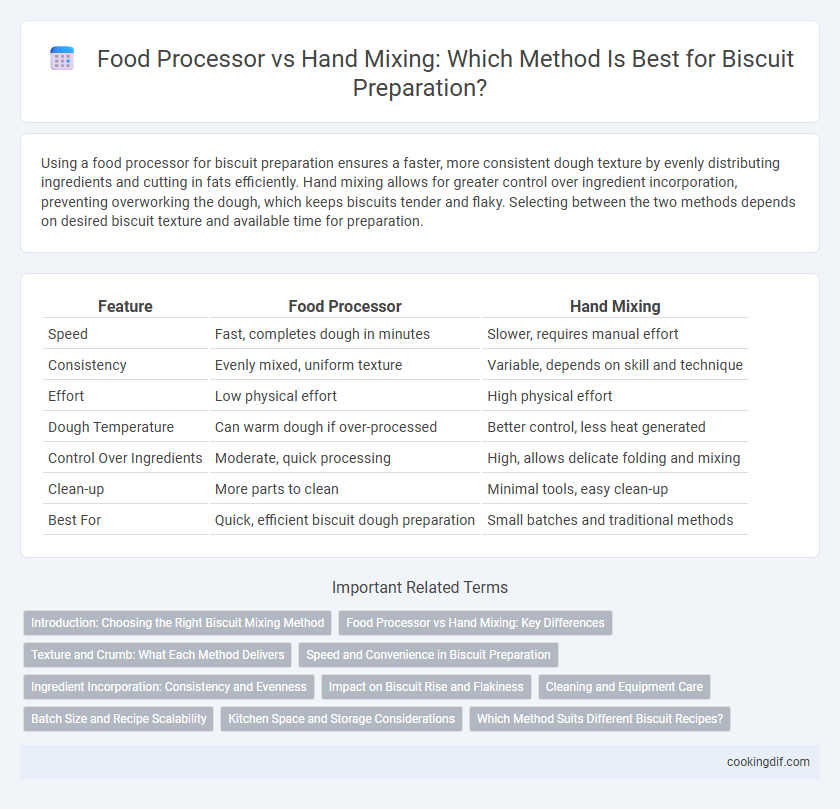Using a food processor for biscuit preparation ensures a faster, more consistent dough texture by evenly distributing ingredients and cutting in fats efficiently. Hand mixing allows for greater control over ingredient incorporation, preventing overworking the dough, which keeps biscuits tender and flaky. Selecting between the two methods depends on desired biscuit texture and available time for preparation.
Table of Comparison
| Feature | Food Processor | Hand Mixing |
|---|---|---|
| Speed | Fast, completes dough in minutes | Slower, requires manual effort |
| Consistency | Evenly mixed, uniform texture | Variable, depends on skill and technique |
| Effort | Low physical effort | High physical effort |
| Dough Temperature | Can warm dough if over-processed | Better control, less heat generated |
| Control Over Ingredients | Moderate, quick processing | High, allows delicate folding and mixing |
| Clean-up | More parts to clean | Minimal tools, easy clean-up |
| Best For | Quick, efficient biscuit dough preparation | Small batches and traditional methods |
Introduction: Choosing the Right Biscuit Mixing Method
Selecting the optimal mixing method for biscuit preparation significantly influences dough texture and final biscuit quality. Food processors ensure rapid, even mixing that minimizes gluten development, producing tender, flaky biscuits, while hand mixing offers greater control over dough consistency and allows for gentle folding of ingredients to maintain flakiness. Understanding the differences in mixing techniques helps bakers achieve desired biscuit characteristics tailored to specific recipes and textures.
Food Processor vs Hand Mixing: Key Differences
Food processors offer consistent mixing and uniform dough texture for biscuit preparation, reducing preparation time compared to hand mixing. Hand mixing provides greater control over dough consistency and allows for gentle incorporation of ingredients, which can lead to a flakier biscuit texture. While food processors streamline the process, hand mixing remains preferred for traditional, artisanal biscuits requiring delicate handling.
Texture and Crumb: What Each Method Delivers
Food processors create a consistently fine crumb and tender texture by quickly cutting butter into flour, preventing overmixing and ensuring even fat distribution. Hand mixing often results in a slightly coarser crumb with varied texture, allowing for more control but requiring careful technique to avoid dense biscuits. Both methods influence flakiness and rise, with food processors typically producing lighter, more uniform biscuits.
Speed and Convenience in Biscuit Preparation
Using a food processor for biscuit preparation significantly reduces mixing time, creating a uniform dough in seconds compared to the manual effort required for hand mixing. The convenience of a food processor minimizes physical strain, ensuring consistent texture and faster completion, ideal for busy kitchens. Hand mixing offers greater control but demands more time and effort, often leading to uneven dough and slower preparation.
Ingredient Incorporation: Consistency and Evenness
Food processors ensure rapid and uniform ingredient incorporation, producing consistently smooth biscuit dough ideal for even baking. Hand mixing allows more control over texture but may result in uneven distribution of fats and flour, potentially causing inconsistent biscuit crumb. For optimal biscuit quality, food processors deliver superior consistency and evenness in ingredient blending compared to manual methods.
Impact on Biscuit Rise and Flakiness
Using a food processor for biscuit preparation ensures even cutting of fat into flour, promoting superior biscuit rise and a flaky texture by creating uniform layers. Hand mixing can be less consistent, often leading to uneven fat distribution and denser biscuits with less lift and flakiness. Precise control of mixing time and technique with a processor minimizes gluten development, critical for tender, airy biscuits.
Cleaning and Equipment Care
Food processors streamline biscuit preparation by minimizing dough contact, reducing residue buildup and simplifying cleaning with detachable, dishwasher-safe parts. Hand mixing requires careful attention to thoroughly wash bowls and utensils, as dough tends to cling stubbornly to surfaces, increasing cleaning time. Proper equipment care enhances longevity, with food processors demanding routine blade sharpening and hand-mixing tools needing consistent drying to prevent rust and maintain performance.
Batch Size and Recipe Scalability
Food processors enable efficient preparation of large biscuit batches with consistent dough texture, making them ideal for scaling up recipes in commercial or high-volume settings. Hand mixing suits small-batch biscuit recipes where control over ingredient integration and dough consistency is crucial, but it may become labor-intensive and less uniform as batch size increases. Scaling biscuit recipes is more precise and time-effective using a food processor, especially when consistent mixing speed and temperature control impact dough quality.
Kitchen Space and Storage Considerations
Food processors save kitchen space by combining multiple functions into one compact appliance, reducing the need for extra tools during biscuit preparation. Hand mixing requires minimal storage since it involves just basic utensils like bowls and spoons, ideal for small kitchens with limited cabinetry. Choosing between them depends on balancing countertop space availability with storage capacity for bulky electric devices.
Which Method Suits Different Biscuit Recipes?
Food processors offer precise control and speed, making them ideal for flaky biscuits requiring cold butter cut into flour evenly, such as buttermilk or layered biscuits. Hand mixing suits recipes like drop biscuits or those with delicate ingredients, allowing gentle incorporation to maintain tender texture and crumb. Choosing between methods depends on biscuit type: food processors excel in consistency and speed for structured dough, while hand mixing preserves texture in softer, rustic varieties.
Food processor vs hand mixing for biscuit preparation Infographic

 cookingdif.com
cookingdif.com